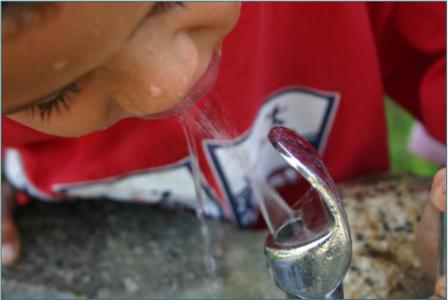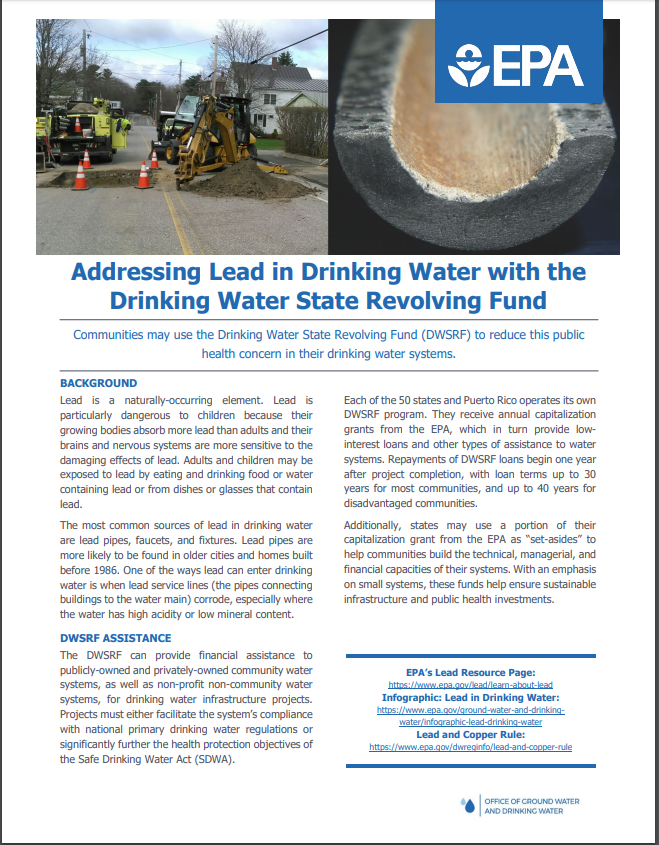Funding for Lead Service Line Replacement
Improving America’s water infrastructure is vital to protecting public health and reducing lead in drinking water. Federal and non-federal funding sources are available to assist states and water utilities with these efforts, including lead service line replacement (LSLR).
On this page:
- Drinking Water State Revolving Fund (DWSRF)
- HUD Community Development Block Grant (CDBG)
- Assistance for Small and Disadvantaged Communities Grant
- Lead Testing in School and Child Care Drinking Water Grant
- Reducing Lead in Drinking Water Grant
- Water Infrastructure Finance and Innovation Act (WIFIA)
- Additional Lead in Drinking Water Funding
Drinking Water State Revolving Fund
The Drinking Water State Revolving Fund (DWSRF) has provided loans that directly supported lead pipe replacement projects in cities across the United States.
Over the years, EPA has provided states $20 billion through the DWSRF program for infrastructure improvements, including lead service line replacement projects throughout the country; totaling $1.126 billion for the fiscal year 2019.
Through October 4, 2020, states may transfer funds from their Clean Water State Revolving Fund (CWSRF) to their DWSRF to address lead-related threats to public health in drinking water. These funds must be used for DWSRF-eligible, lead-related projects and must be used for loans with principal forgiveness, negative interest rates, and/or grants.
This additional transfer flexibility can help states and local governments finance important projects at lower cost. Details about this temporary authority are located in this memorandum: One Year Inter-SRF Transfer Authority to Address Lead in Drinking Water (PDF).
Eligible Projects
- Infrastructure Replacement: Complete service line replacement is an eligible DWSRF expense, regardless of pipe material and ownership of the property on which the service line is located. The entire service line from the public water main to the point at which it connects with premise plumbing is DWSRF-eligible.
- Corrosion Control Optimization: Corrosion control planning and design, as well as associated capital infrastructure projects, are eligible for DWSRF loan funding. States may also use set-aside funds to assist water systems’ development of corrosion control strategies (e.g. adding chemicals to modify drinking water chemistry).
- Lead Testing and Education: States can use set-aside funds to present workshops, seminars, and other training events that provide operators with ongoing educational opportunities. Set-aside activities for educational purposes may include training school staff members or small system operators on how to perform lead monitoring and testing. Pilot testing and lead sampling (if not for compliance purposes) may also be eligible for set-aside funding.
- Interim/Emergency Protocols: In the case of a “do not drink” order or other lead emergencies, states may use set-aside funds for limited infrastructure that is necessary for trucked-in water (i.e., storage tank and associated piping). This infrastructure must belong to the water system and ownership must continue after the emergency has concluded. Trucked-in water and bottled water are ineligible for DWSRF assistance.
The Safe Drinking Water Act (SDWA) authorizes EPA to set aside a portion of each year’s DWSRF appropriation and use it to make direct grants for capital improvements to public water systems that serve tribes. Both community and non-profit non-community water systems serving tribal members have eligibility for grants administered through EPA’s Drinking Water Infrastructure Grants Tribal Set-Aside (DWIG-TSA) Program.
Applying for Funding
Water systems receive DWSRF assistance directly from state agencies. Each state has its own application procedure. Contact information for each state is available online.
Tribal public water systems receive DWIG-TSA assistance directly from EPA Regions. Please contact your EPA Regional office Infrastructure Grant Tribal Set-Aside Coordinator for details. Tribes are also eligible to receive support from state DWSRF programs through their state contacts.
View additional information about the DWSRF Program.
HUD Community Development Block Grant (CDBG)
The Community Development Block Grant (CDBG) program is a flexible program that provides communities with resources to address a wide range of unique community development needs. Beginning in 1974, the CDBG program is one of the longest continuously run programs at HUD. The CDBG program provides annual grants on a formula basis to 1209 general units of local government and States.
CDBG is an important tool for helping local governments tackle serious challenges facing their communities. The CDBG program has made a difference in the lives of millions of people and their communities across the Nation.
View information about CDBG tools and eligibilities.
Assistance for Small and Disadvantaged Communities Grant
Authorized under the Water Infrastructure Improvements for the Nation (WIIN) Act, EPA's Assistance for Small and Disadvantaged Communities Drinking Water Grant program assists public water systems in underserved, small, and disadvantaged communities in meeting Safe Drinking Water Act (SDWA) requirements. The grant will include approximately $42.8 million in funding for 2019.
For the purposes of this Grant Program, a disadvantaged community is one determined by the state to be disadvantaged under the affordability criteria established by the State under section 1452(d)(3) of the SDWA, or may become a disadvantaged community as a result of carrying out a project or activity.
A project in a small community is eligible for assistance if the community served has a population of less than 10,000 individuals and lacks the capacity to incur debt sufficient to finance a project to comply with the SDWA.
Eligible Projects
Grants can be used to support projects and activities in underserved, small and disadvantaged communities that include:
- Investments necessary for a public water system to comply with SDWA
- Assistance that directly and primarily benefits a disadvantaged community
- Programs to provide household water quality testing, including testing for unregulated contaminants
- Activities necessary and appropriate for a State to respond to a contaminant
Example project and activity categories are:
- Treatment
- Transmission and Distribution
- Storage
- Consolidation
- Household water quality testing, including for unregulated contaminants
- Assistance to increase technical, managerial, and financial capacity
-
Drinking water contamination response efforts
Applying for Funding
The Grant Program is a noncompetitive program. Eligibility to apply for and receive funds is limited to the geographical 50 states, Puerto Rico, the U.S. Virgin Islands, Guam, American Samoa, the Commonwealth of the Northern Mariana Islands, and tribes within the U.S.
Applications from states are now being accepted at www.Grants.gov, CFDA 66.442.
Additionally, the Grant Program includes a tribal allotment of 2% of the funds appropriated. Federally recognized tribes are eligible to recieve tribal grant funds to support activities in communities that meet the requirements of the grant program.
View EPA Regional Contacts by State and Territory.
Lead Testing in School and Child Care Drinking Water Grant
Authorized under the Water Infrastructure Improvements for the Nation (WIIN) Act, EPA's Lead Testing in School and Child Care Program Drinking Water Grant creates a voluntary program to assist with testing for lead in drinking water at schools and child care programs. The grant will include approximately $43.7 million in funding.
Eligible Projects
Grant funds can be used to carry out testing under EPA’s 3Ts for Reducing Lead in Drinking Water in Schools and Child Care Facilities guidance or applicable state regulations or guidance regarding reducing lead in drinking water in schools and child care programs that are not less stringent.
These grant funds may be used for testing in school and child care facility efforts. This may include sample collection and analysis, first draw and flush sampling, the development of sampling plans, training in preparation of sampling, communication related to sampling efforts, use of a contractor to support sampling efforts, and sampling after remediation.
Grant funding cannot be used to replace fountains, fixtures, lead lines or any remediation activity.
Applying for Funding
The Grant Program is a noncompetitive program. Eligibility to apply for and receive funds under the grant program is limited to the 50 states, the District of Columbia, Puerto Rico, the Virgin Islands, Guam, American Samoa, and the Northern Mariana Islands. View the state agencies implementing this grant program.
Additionally, 6.44 percent of appropriated funding will be distributed to assist tribal education agencies (including in Alaska Native Villages) in testing for lead contamination in drinking water at schools and child care programs.
Reducing Lead in Drinking Water Grant
In 2018 and 2019, Congress appropriated $25 million, authorized under the Water Infrastructure Improvements for the Nation (WIIN) Act, for reducing lead in drinking water across the country, including activities such as full lead service line replacement.
Section 2105 of the WIIN Act, Reducing Lead in Drinking Water, creates a new EPA grant program for lead reduction projects. Eligible entities include community water systems, non-governmental organizations, tribal water systems, nontransient noncommunity water systems, and municipality or state, interstate, or inter-municipal agencies.
Eligible Projects
Eligible projects include projects or activities where the primary purpose of which is to reduce the concentration of lead in water for human consumption. Priority will be given to disadvantaged communities with an action level exceedance in the last three years or to address lead levels in school, daycare, or other facility that primarily serves children.
Applying for Funding
The Request for Applications (RFA) will be released in late 2019. To learn more, contact WIINDrinkingWaterGrants@epa.gov.
Learn more about EPA's WIIN Grants
Water Infrastructure Finance and Innovation Act (WIFIA)
Established by the Water Infrastructure Finance and Innovation Act of 2014, the WIFIA program is a federal loan and guarantee program administered by EPA. WIFIA’s aim is to accelerate investment in the nation’s water infrastructure by providing long-term and low-cost supplemental credit assistance for regionally and nationally significant projects. The WIFIA program has an active pipeline of pending applications for projects that will result in billions of dollars in water infrastructure investment and thousands of jobs.
Learn more at about the WIFIA Program.
Additional Lead in Drinking Water Funding
Funding Sources for Schools and Child Care Facilities
EPA has compiled a list of funding sources for improving drinking water quality in schools and child care facilities. This compiled list of 200 sources are from federal partners, associations, non-profits, and organizations. These can be used to test drinking water, implement remediation measures, and replace old plumbing fixtures and service lines.

